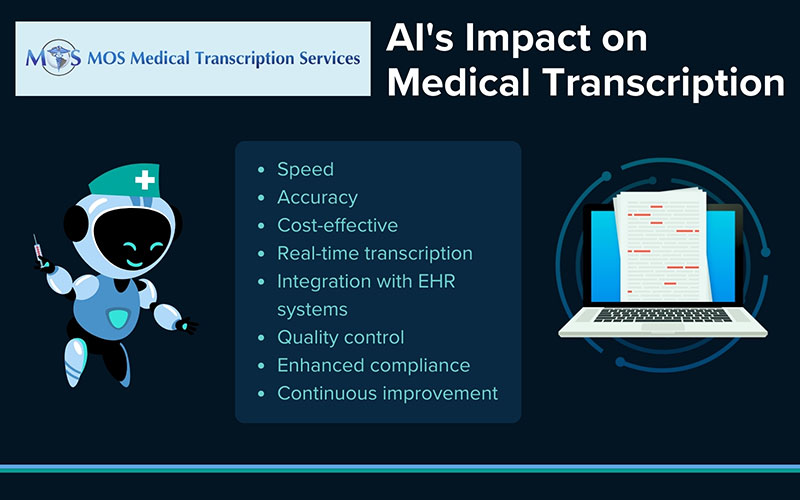
Table of Contents
Clinical documentation requirements have increased significantly with the shift from paper-based to electronic health records (EHRs). Many clerical tasks have also become additional physician responsibilities and EHR data entry is one of them. Medical transcription services offer the solution by ensuring that physician dictation is converted into text format for integration into the (Electronic Health Record) EHR.
A 2023 study examined the prevalence of burnout symptoms among U.S. physicians across four intervals from 2011 to 2021. The repercussions of burnout in healthcare are evident in medical errors, diminished care quality, safety lapses, lower patient satisfaction, and turnover within the primary care workforce. The study identified EHRs and time constraints among the contributing factors to these problems.
By entrusting the note-taking process to a third-party service provider, physicians can get more time to focus on patient care. In the past, medical transcription relied on medical scribes who would listen to physicians’ dictations and transcribe them manually. This conventional method was not only time-consuming but also susceptible to human errors. However, the advent of AI-powered medical transcription has revolutionized the process.
How is AI transcription impacting the medical transcription process?
How Transcription Services and AI handle Medical Documentation
To understand the impact of AI on transcription, let’s first consider manual option. In a medical transcription company, a team of trained and experienced professionals handle the audio-to-text conversion process. They can accurately transcribe complex dictations and medical terminology, ensuring accurate EHR-integrated documentation. However, the conventional manual process is often laborious, demanding continuous communication and coordination between physicians and transcriptionists, resulting in iterative exchanges. This can significantly increase the turnaround time for medical documentation.
AI transcribes audio recordings much faster than human transcriptionists, revolutionizing the way healthcare professionals document and manage patient records. AI-powered clinical documentation systems leverage speech recognition technology to capture and transcribe a clinician’s dictation in real-time. These advanced tools utilize sophisticated algorithms that listen to the spoken words and convert them into written text.
Key Aspects of AI-powered Medical Transcription
Here are some key ways in which AI has influenced medical transcription:

- Speed: AI transcription speech recognition technology enables healthcare providers to generate comprehensive patient notes in a fraction of the time that humans take. A typical turnaround time for a 30-minute audio or video file is 5 minutes for automated transcription services, while same file could take 2 or 3 days for human transcriptionists according to Sonix. AI enables healthcare providers to generate patient reports and documentation more quickly, facilitating faster diagnosis, treatment, and decision-making.
- Accuracy: AI utilizes Automatic Speech Recognition (ASR) technology to convert spoken words into written text. These systems have the capability to swiftly process substantial amounts of audio data in real-time, leading to a significant reduction in the time required for documentation. AI-powered tools leverage advanced natural language processing (NLP) algorithms to transcribe medical dictations with high accuracy. These algorithms enable the AI to grasp the context and significance of words, resulting in contextually relevant transcriptions. AI transcription solutions can be trained and customized to recognize specialized medical terminology and accents, ensuring accurate transcription across various medical specialties and regional dialects. Even so, AI transcription can be less accurate than human transcription. Having machine-generated content reviewed by human medical transcriptionists can address any inaccuracies.
- Cost-effective: Automated transcription is considerably less expensive than human transcription. AI helps healthcare facilities save on labor costs associated with hiring human transcriptionists, while also reducing the need for outsourcing transcription.
- Real-time transcription: AI-driven transcription tools can transcribe dictations in real-time, allowing healthcare professionals to access patient records immediately after consultations or procedures, leading to faster decision-making and improved patient care.
- Integration with EHR systems: AI transcription platforms automatically integrate seamlessly with EHR systems, enabling population of patient records with transcribed information. Seamless transfer of the transcribed notes directly into the system eliminates the need for manual entry and optimizes documentation workflows.
- Quality control: AI transcription systems often come equipped with built-in quality control mechanisms. They can automatically flag potential errors or inconsistencies in transcribed documents, allowing human reviewers to focus on reviewing and correcting specific sections rather than transcribing the entire text. This helps maintain high standards of accuracy and ensures the reliability of medical documentation.
- Enhanced compliance: AI transcription systems can help healthcare organizations maintain compliance with regulatory requirements such as HIPAA by employing advanced security measures to protect patient data during transcription and storage.
- Continuous improvement: AI transcription technology continuously learns and improves over time as it processes more data, leading to ongoing enhancements in accuracy, efficiency, and user experience.
Overall, the integration of AI into medical transcription processes holds great potential for improving workflow, care delivery, and productivity in healthcare settings. However, while it can lead to cost savings in the long-term, deploying and integrating AI systems initially may necessitate a substantial investment, particularly when it comes to safeguarding sensitive patient data.
The Bottom Line
AI transcription should be viewed as a complementary tool rather than a complete replacement for human involvement in healthcare. While AI systems excel at processing and transcribing large volumes of data, human oversight remains crucial to guarantee the accuracy and quality of medical documentation. The expertise and judgment of experienced human transcriptionists are essential for interpreting complex medical information, ensuring proper context, and addressing any potential errors or discrepancies that AI may overlook. A collaborative approach that combines the strengths of AI technology with the expertise offered by a medical transcription company can ensure optimal results in medical documentation.


